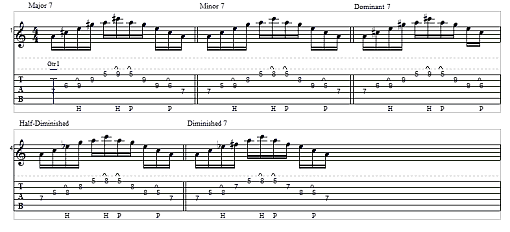Hello all, and welcome to an e-ticket to arpeggio-land. For the uninitiated, an arpeggio is the notes of a chord played individually, and while there are many ways of playing arpeggios there are few that are as powerful and rich sounding as arpeggios using extended voicings. This column will not get too far into the weeds of the really, really, extended voicings, But we will cover the beautiful seventh chord arpeggios. These will give added dimension to solos, and can be really useful in breaking the cliches we are all guilty of from time to time.
I understand that for some of you this will seem a little pedestrian, but a seventh chord arpeggio contains the root, third, fifth, and seventh of a scale. The formulas for the arpeggios we will be discussing are major (1-3-5-7), minor (1-b3-5-b7), dominant (1-3-5-b7), half diminished (1-b3-b5-b7), and diminished seventh (1-b3-b5-bb7). The tab for the shapes is below, but what you can do with these shapes is very cool.
Number one, you can apply these arpeggios diatonically, meaning build them off of the key center of the scale you are playing in using this formula: 1st scale step (major 7)-2nd scale step (minor 7)-3rd scale step (minor 7)-4th scale step (major 7)-5th scale step (dominant 7)-6th scale step (minor 7)-7th scale step (diminished-Half-diminished). Once you have built the arpeggios diatonically you are free to use them as a starting point for licks and phrases in the key of the song you are improvising over. Just be careful about your phrasing and recognize that just because a note belongs to the key, it doesn't mean it is a good note to resolve on - so keep your ears engaged.
The second way to use these arpeggios is to outline the chords you are playing over by playing the arpeggio that matches the chord. This is particularly useful in metal, as the primary chords will be root fifth power chords, which don't offer very much in the way of harmony. So, in essence, you will be implying a more complex harmony with your arpeggios than is heard in the actual chords that you are playing over. This adds up to a very lush sounding sonic texture that adds, dare I say, a hint of sophistication to your lines. Good luck.

Scott Allen is a 1996 graduate of the Musician's Institute, G.I.T. He currently teaches guitar to 65 to 70 students weekly at Northridge Music Center.
His latest CD is entitled "III", featuring his impressively fluid playing, with a style marked by an incendiary sense of phrasing.